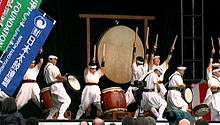Nippon Taiko Foundation
The Nippon Taiko Foundation (日本太鼓財団, Nippon taiko zaidan), formerly referred to as Nippon taiko renmei (日本太鼓連盟) is a Japanese governmental organization and is the largest national organization of taiko performance groups active in Japan. As of 2012, the Foundation represents over 800 taiko groups, approximately 20,000 individuals, and is made up of 34 leagues corresponding to some Japanese prefectures.
日本太鼓財団 | |
 | |
| Abbreviation | NTF |
|---|---|
| Predecessor | 日本太鼓連盟 |
| Formation | November 7, 1997 |
| Founder | Daihachi Oguchi |
| Type | Governmental organization |
| Legal status | Active |
| Purpose | Promotion and preservation of taiko performance |
| Headquarters | Tokyo, Japan |
| Location |
|
| Coordinates | 35.6700942°N 139.7449633°E |
Official language | Japanese |
Chairman | Hideaki Matsumoto |
Parent organization | Agency for Cultural Affairs |
| Affiliations | The Nippon Foundation |
| Website | http://nippon-taiko.or.jp/english/ |
History
The predecessor to the current Nippon Taiko Foundation was founded in 1979 by Daihachi Oguchi, the developer of contemporary taiko performance. Generally, membership in this organization only included groups that Oguchi had taught or trained. The group had two goals: to develop productive relations with active taiko groups, and to publicize and teach taiko performance techniques.[1]
Membership in the Foundation increased substantially in the 1980s. There were few experienced teachers who were available to teach newer members, and prompted concerns from organizational leadership that it would not be feasible to accommodate demand, particularly because taiko was normally taught orally.[2] To resolve this problem, Oguchi developed a textbook called Japan Taiko (日本の太鼓) that was published in 1994.[3][4] However, leadership at the Foundation were not satisfied with the publication because they felt it was written too heavily in favor of Oguchi's specific performance methods, and that it lacked a general set of fundamental performance techniques that would allow for an organized certification process.[5] The Foundation later published a more recent textbook in 2001 called the Nihon Taiko Textbook (日本太鼓教本, Nihon taiko kyōhon) that provides a set of basic techniques, such as how to hold a percussion mallet and suggested stretching methods to prepare for performance.[5] The textbook has been revised and was republished in 2006.[6]
In 1997, the organization was renamed in Japanese from Nippon taiko renmei (日本太鼓連盟) to Nippon taiko zaidan (日本太鼓財団), but is still referred to as the Nippon Taiko Foundation in English.[7]
Membership

The Foundation has generally been recognized for its work in connecting taiko performance groups across Japan and internationally.[8] As of 2012, the Foundation represents over 800 taiko groups, approximately 20,000 individuals, and is made up of 34 leagues corresponding to some Japanese prefectures. It also has a membership of over 8000 certified instructors of taiko performance at various levels both within and outside Japan.[9]
References
Citations
- Bender 2012, p. 179.
- Bender 2012, p. 183.
- "Nihon no taiko : Fukushiki fukudahō kyōhon : Kumidaiko". Worldcat.org. Retrieved 25 November 2015.
- Pachter 2013, pp. 38–39.
- Bender 2012, p. 185.
- Pachter 2013, pp. 39.
- "プロフィール". Nippon Taiko Foundation (in Japanese). Retrieved 25 November 2015.
- Cangià 2013, p. 129.
- "日本太鼓連盟". Nippon Taiko Foundation (in Japanese). Retrieved 25 November 2015.
Bibliography
- Bender, Shawn (2012). Taiko Boom : Japanese drumming in place and motion (1st ed.). Berkeley: University of California Press. ISBN 9780520272415.CS1 maint: ref=harv (link)
- Cangià, Flavia (2013). Performing the buraku : narratives on cultures and everyday life in contemporary Japan. Berlin: Lit Verlag. ISBN 364380153X.CS1 maint: ref=harv (link)
- Pachter, Benjamin (2013). Wadaiko in Japan and the United States: The Intercultural History of a Musical Genre (PhD). University of Pittsburgh. OCLC 854984650. Retrieved 25 November 2015.CS1 maint: ref=harv (link)